Recommendations for slope reinforcement
Before shaping a slope on a site, it needs to be reinforced and protected from collapses. But first, evaluate:
- how deep is the groundwater;
- what is the slope of the site;
- how high is the ground pressure;
- what is the composition of the soil.
This knowledge will help you correctly select and place retaining walls or their alternative, and therefore preserve the created landscape for a long time.
Let’s start strengthening work:
- Plant plants with developed strong roots to support a relief area with a slight slope.
- Build small retaining walls if the slope is strong and the pressure on the ground is high. Later, we will analyze the advantages and disadvantages of retaining walls made of different materials.
- Lay geotextiles, which will help protect the soil from mixing and shifting. Suitable for slopes up to 60 degrees. Use geomats in windy areas: intertwining with roots, they form a stable coating that protects against erosion.
- Lay a durable geogrid: it follows the relief, strengthens, protects against soil erosion and avalanche.
- Include decorative gabions in the landscape design of the site on the slope: they add style, protect against movement, and become stronger and more reliable over the years.
- Mount low monolithic fences (made of brick, slabs, stone) along the contour and between zones – they do not require maintenance, are an excellent alternative to retaining walls.
Retaining walls are made of:
- Stone. The main advantage is its natural origin and durability. It looks appropriate surrounded by grass and trees, easily fits into a design project for decorating a site on a slope. The ancient technology of dry masonry is complex, requires knowledge and skills: ideally matching blocks are selected, they are laid without mortar, and such a structure will last for many years. Modern technologies make laying easier: the parts are fastened with cement mortar, so it is not necessary to select stones by shape. The gaps are sometimes filled with crushed stone.
- Wood. It is pre-treated with protective impregnations. In the construction of retaining walls, wood of different cross-sections is used: round, square, flat. Natural wood also easily fits into the design of the site, but unlike the first option, it is not as strong – therefore, the height of the structure is limited to ~ 35 cm. To hold the boards or logs, they are reinforced with metal supports or concrete mortar.
- Brick. Despite its industrial origin, red brick goes well with lush greenery and bright buds. The brickwork is laid using concrete, the retaining wall is strong and wear-resistant. Before construction, the foundation is poured – it will preserve the structure for many years to come.
Terracing
The most important stage of landscaping a site on a slope, often combined with the construction of retaining walls – terracing. By creating terraces, you can not only stop erosion, but also effectively plan a site on a slope with maximum use of usable space.
Basic rules for soil terracing:
- The greater the slope of the site, the narrower the “steps” are made and vice versa.
- The work is carried out strictly at the beginning of autumn or spring.
- It is necessary to install a storm drain, which will not allow rain to wash away the terraces.
- The location, size and number of buildings are determined in advance.

The photo shows 3 levels of terraces on the site
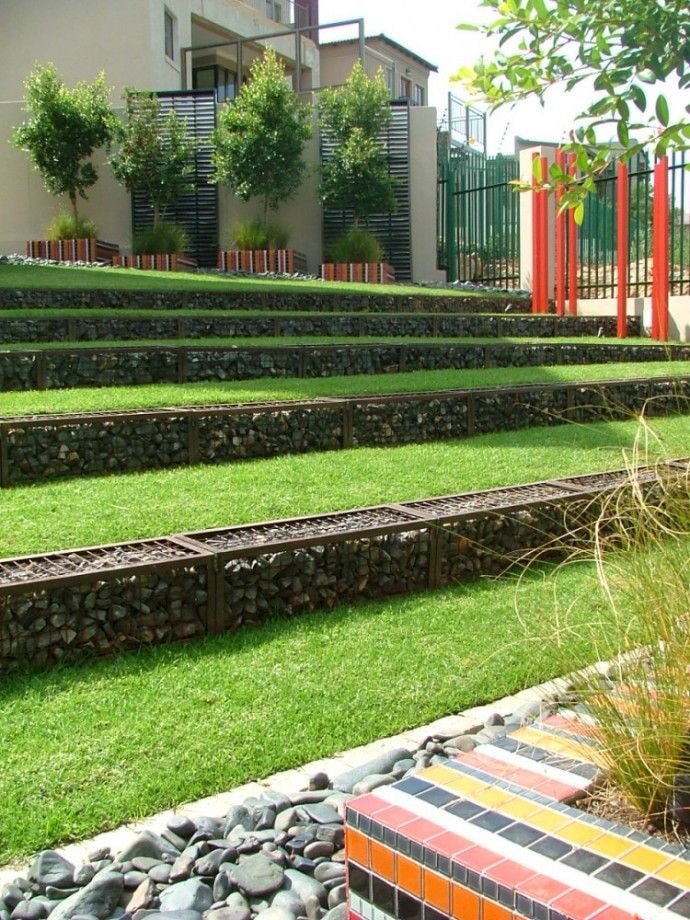
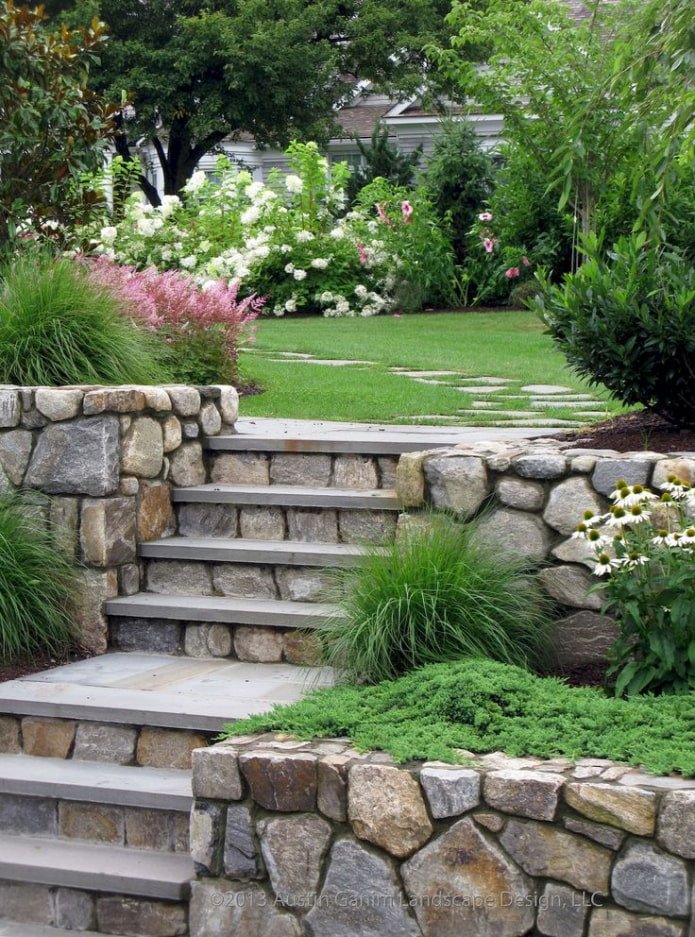
There are 4 types of terraces, each of which has its own characteristics and is used on different land relief areas:
- Ridge. Suitable for slopes of 8-12 degrees. Small embankments are made across the slope, maximum 30-50 cm high. Most often used for vineyards.
- Stepped. Suitable for slopes of 8-12 degrees. Most often, they are used to decorate suburban areas. The steps are 3-15 meters wide and are reinforced with walls.
- Trenches. Suitable for slopes from 10 degrees. Used for growing tea, coffee, and citrus fruits.
- Ditches. Suitable for slopes of 35-40 degrees. They pour up shafts from soil taken from storm drains. In this case, each subsequent rampart is higher than the previous one.
Any terrace consists of a platform, an internal and external slope, a berm (a section between two platforms).
Work on differences in height is specific, so it is best to entrust the arrangement to specialists: they will develop a plan, mark out the territory, strengthen the slopes and make even embankments on which you can arrange a house, design a vegetable garden and a recreation area.

The photo shows an example of dry stone masonry

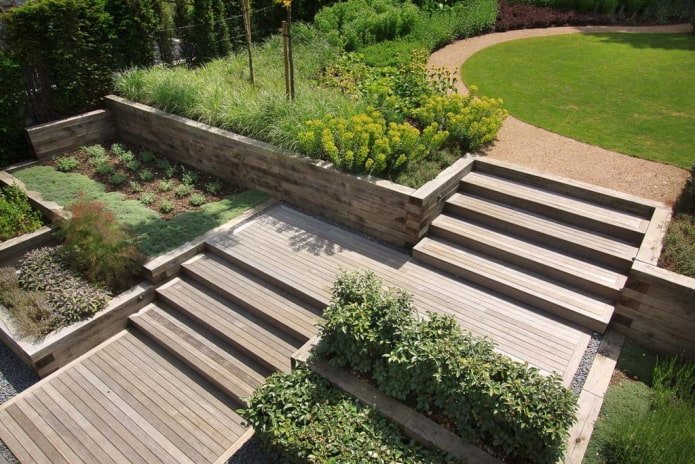
What is the best way to locate the house and buildings?
The construction of the house directly depends on the level of the slope and geological measurements (soil composition, water table). The accuracy of these indicators determines the correctness of the choice of foundation and, accordingly, the strength of the structure.
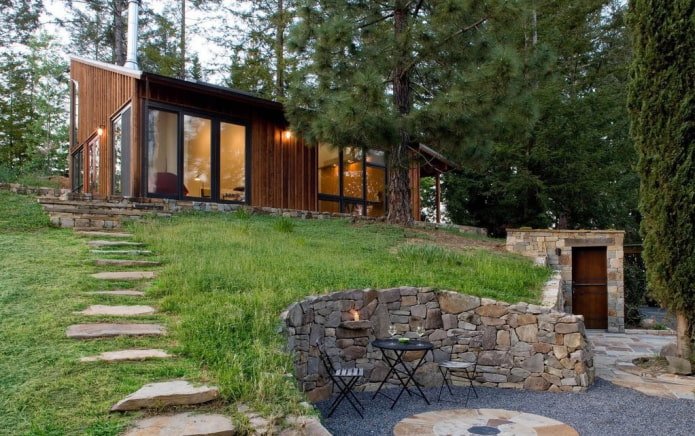
The photo shows a modern house from above
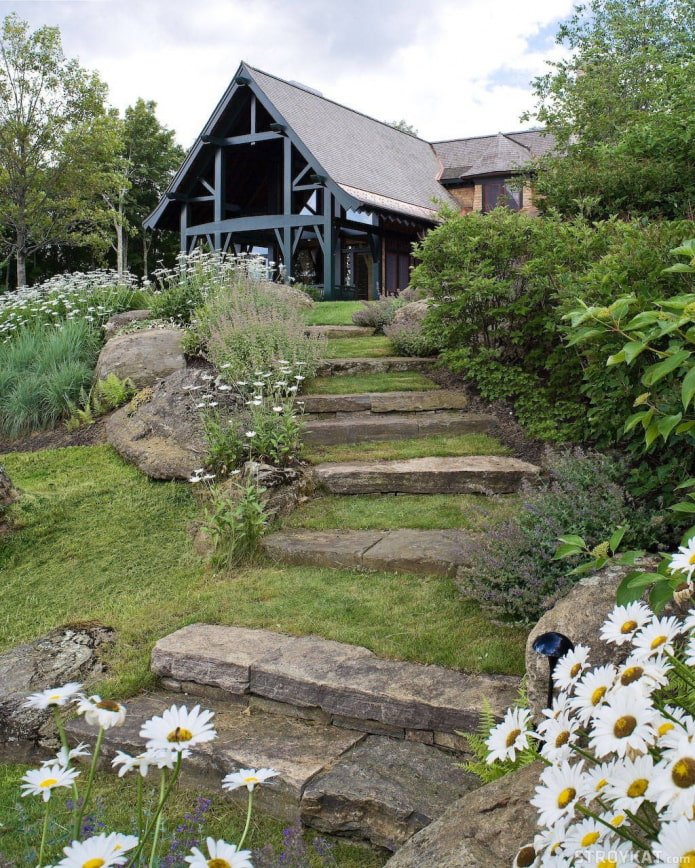
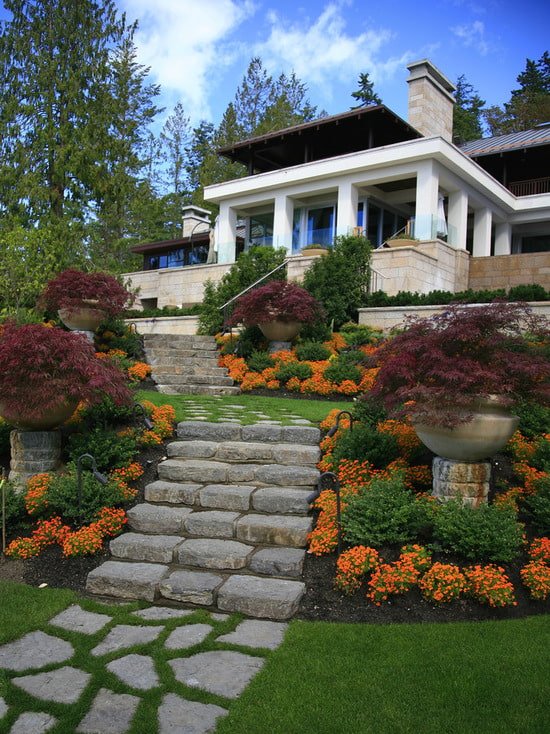
The following knowledge will help you correctly locate your house on a slope:
- Direction of the sun. It will be warmest on the southern and western slopes. If you live in a harsh climate, this is the best option – you can save on heating and admire beautiful sunsets.
- Entrance. This factor is extremely important at the construction stage: you need to think about how the materials will be delivered. And in the future, you will have to drive on the road almost every day – so the distance from the parking lot to the entrance to the house should not be too long.
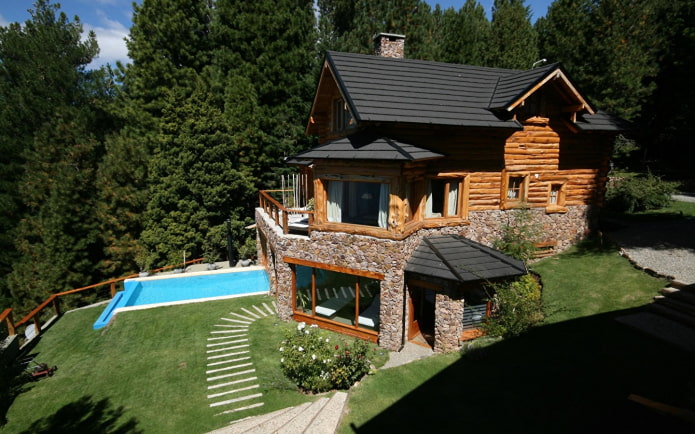
The photo shows a large house with a pool in a lowland

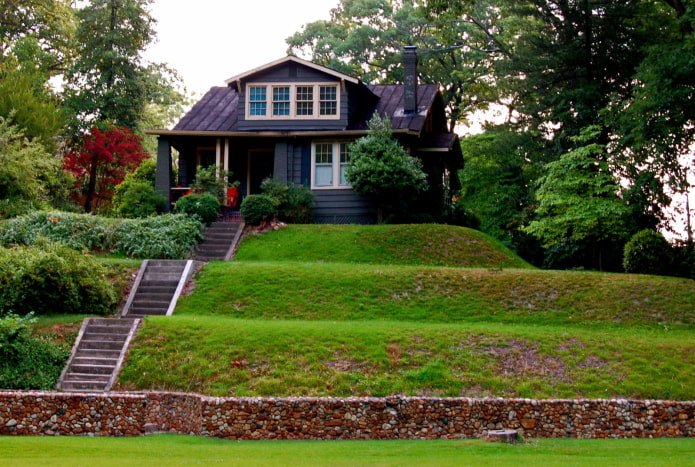
- Communications. One of the most important and fundamental points is how the water will approach, where the drainage ditch will be, whether it will be possible to stretch the wires from the power line.
- Location on the slope. If you are going to live at the very top – that’s great, just place the house on top. But most often there are neighbors above and below the site – so you will have to take into account at least the upper ones, or more precisely, the location of their drainage system.
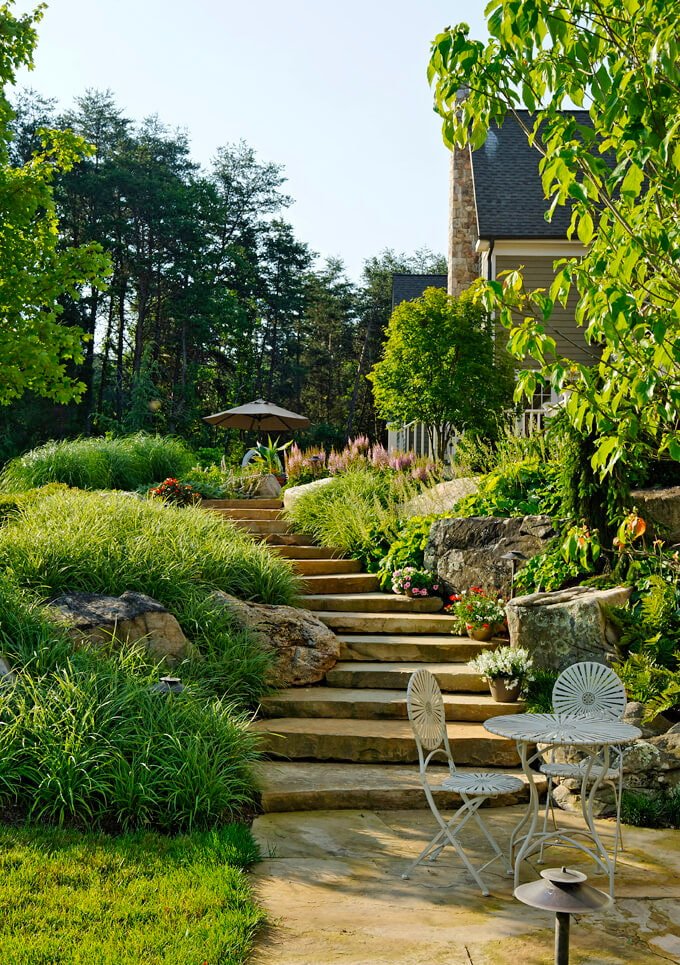
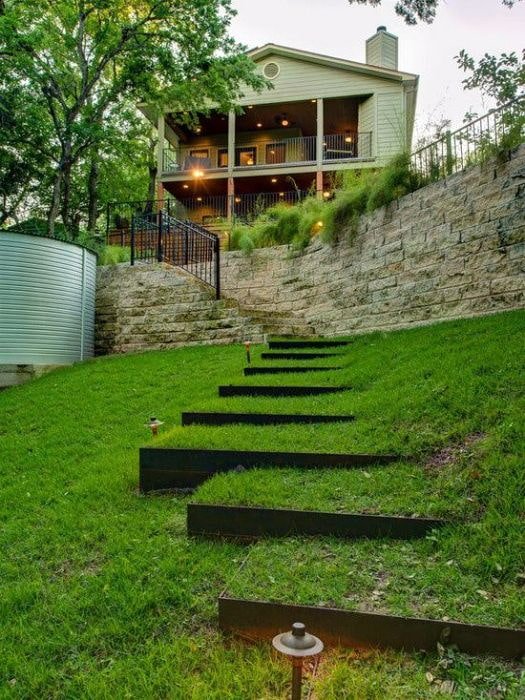
Nuances for arranging paths
Be prepared for the fact that you will have to walk on the site on the slope. To make movement comfortable, think through the system of paths and stairs in advance.
The paths between two terraces are made winding – unlike straight or serpentine paths, it is physically easier to climb up and down them.
The ascent must be equipped with a comfortable staircase. If the slope is steep and there are a lot of steps planned, make platforms between them – preferably with comfortable garden benches or gazebos, especially if elderly people plan to visit or live in the house.
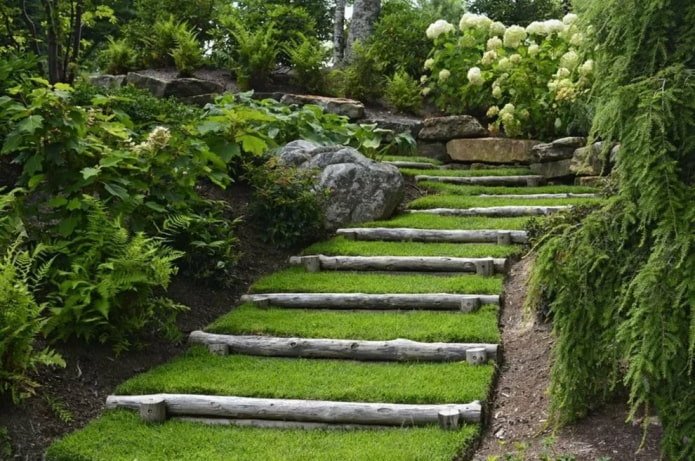
The photo shows timber stairs

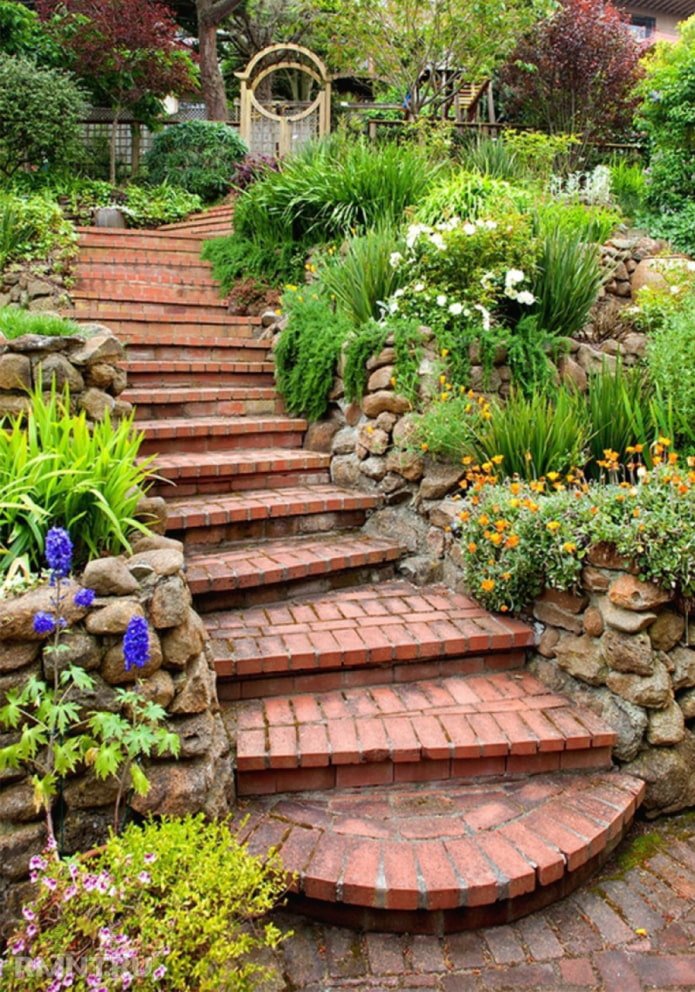
Paths and stairs are most often made of the same material as the supporting walls – this way the overall appearance is more harmonious. But consider the safety of the surface: during rain and snow the surface should not become slippery, otherwise walking along the paths will be life-threatening. Usually, porous stone or unpolished wood is chosen.
The contours of the paths are decorated with stone, wooden or green borders, flowers, evergreen trees, and neat shrubs are planted along them.

The photo shows paved paths with an incline
What should be taken into account when landscaping a site?
Before starting landscape design of a site on a slope, evaluate the following characteristics:
- Location. The southern slope is certainly the most favorable for the rapid growth of plants. For the northern slope, you need to choose certain shade-loving varieties.
- Slope. Not all seedlings can live at an angle – green straight terraces, and for slopes, choose groundcover species with a modest root system.
- Soil. What does the soil on your summer cottage consist of? It is easier to immediately choose suitable plants than to try to adjust the soil to capricious sprouts.
- Humidity. Water flows down, so plants that love moisture will feel good in the lower part.
Any mountain by default is an excellent option for an alpine slide or rock garden. With the help of a multi-tiered flowerbed, you can improve the area around the house or play up the recreation areas between the stairs.
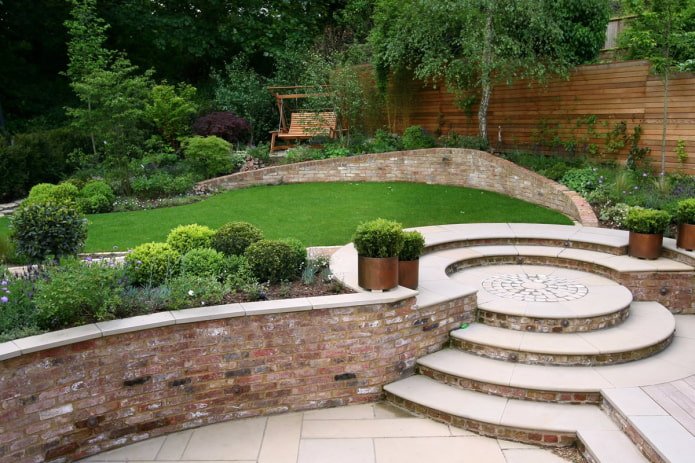
The photo shows a round recreation area near the house
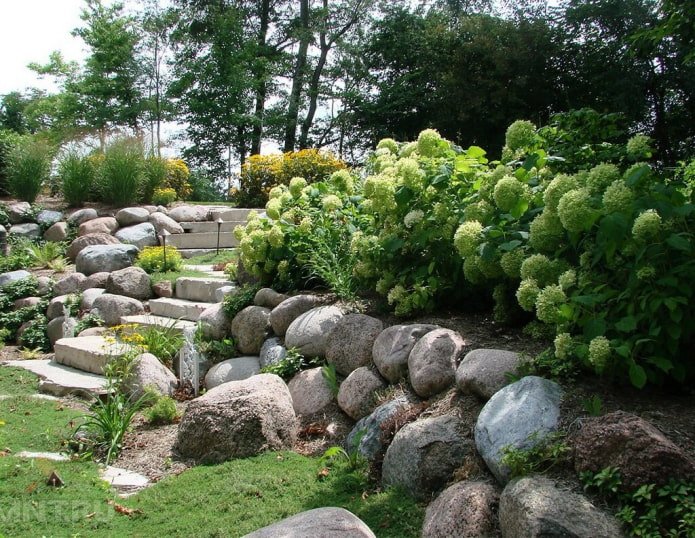
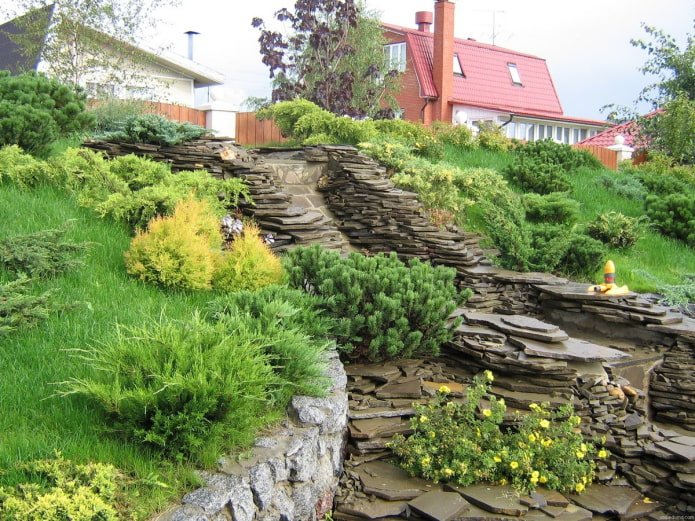
Choosing plants:
Direction of light. Not every flower or shrub will withstand the scorching sun on southern slopes, but drought-resistant sedum, loosestrife, catnip, thyme, and cinquefoil will feel great. Phlox, astilbe, lungwort, periwinkle, and saxifrage are usually placed on the north side.
Location. The higher the altitude, the warmer the air and the drier the soil. Eremurus, sedum, and aubrieta are suitable for these conditions. Barberry, cotoneaster, ligularia, and fern grow well in a damp, cool lowland with good drainage.
Strengthening. Between the terraces, on a slight slope, plants with widely developed roots are planted; they help to hold the soil in place. The most popular are loosestrife, veronica, phlox, ivy, clematis, groundcover rose.
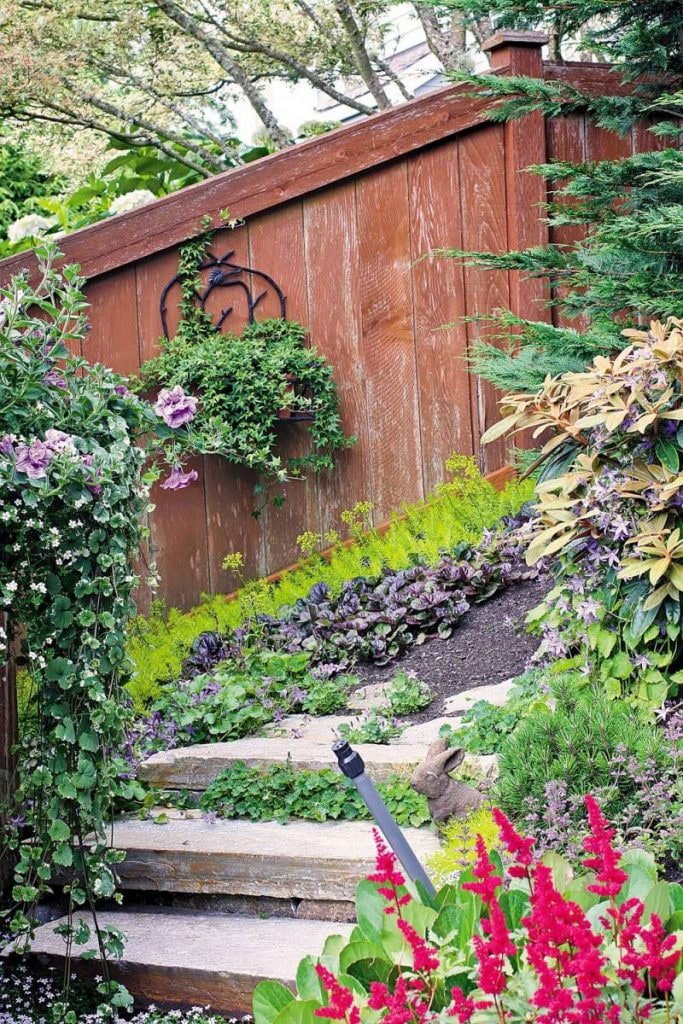
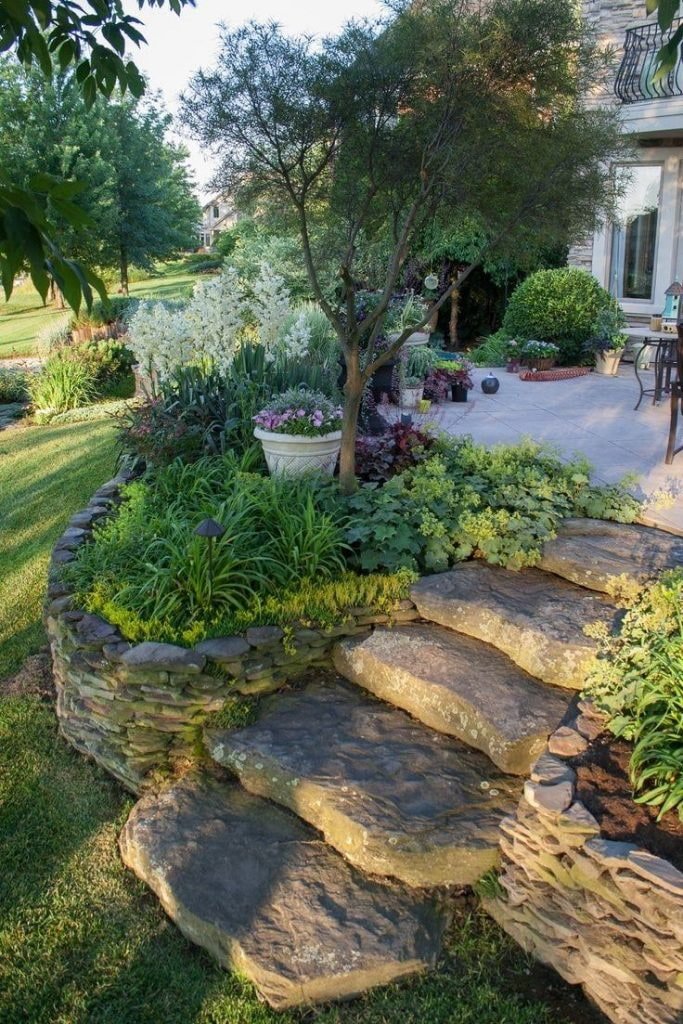
Landscape design ideas
When arranging different zones, take into account not only the direction of the sun, but also the position of the slope:
- Tall or fruit trees are placed at the top, closer to the house. The slope itself is landscaped using shrubs and flowers.
- Ponds, waterfalls, reservoirs and other water structures are lowered down – there they can fill up with groundwater on their own.
- The volumetric look is achieved through natural relief, you only need to emphasize it with plants of varying sizes.
- Use climbing and creeping varieties, vines to play up the walls and fences – fast-growing plants will make the landscape more natural and habitable in the first season.
- Remake narrow terraces into beds: they already have boundaries and do not require much effort when preparing the land for planting.
- Choose a general theme if you find it difficult to think through the combination of plants: for a Japanese or French garden, for example, there are certain rules. Following them, you can easily create a harmonious design for your territory.

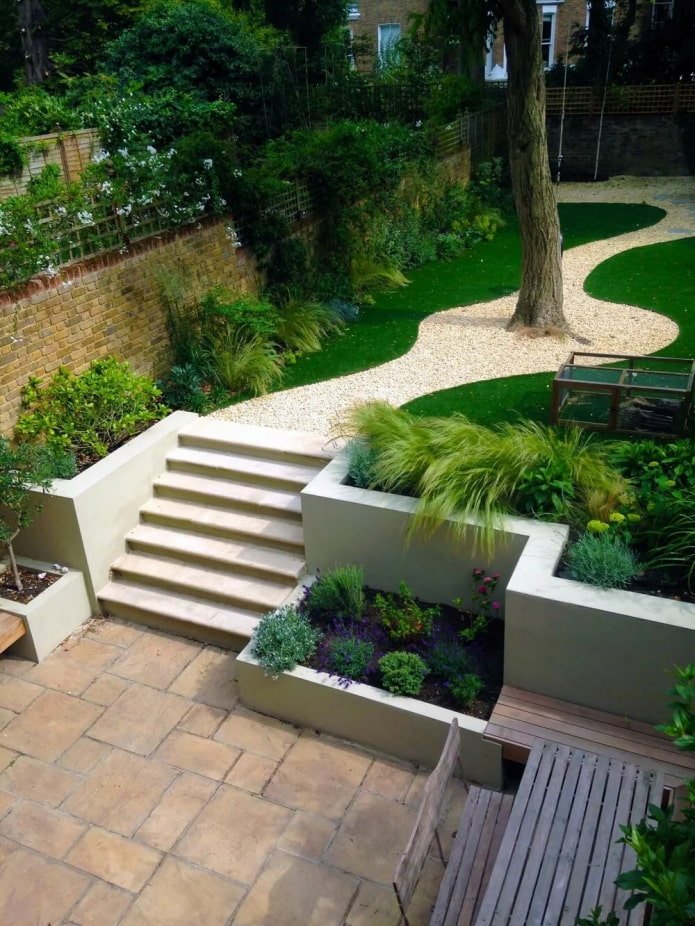

The photo shows an alpine slide on the rise
Now reading:
- Hygge in Interior Design: A Complete Design Guide with 49 Inspiring Photos
- 10 Easy Ways to Disguise Necessary But Unattractive Items
- Entryway Makeover: 10 Inspiring Before and After Renovations
- Stylish ideas and photos: 55 options for green wallpaper for the kitchen.
- Gray Living Room: 55 Inspiring Photos and Design Ideas for Decorating.